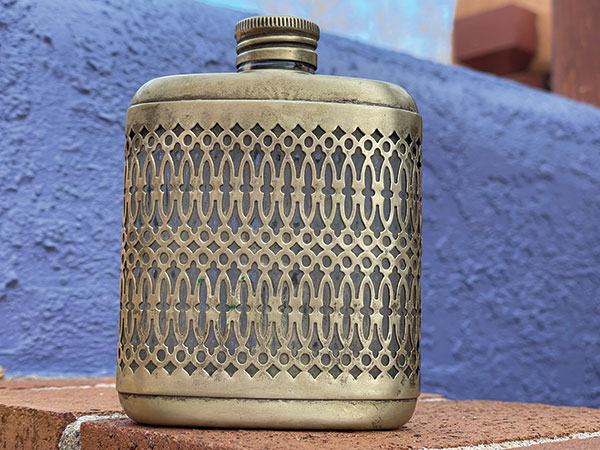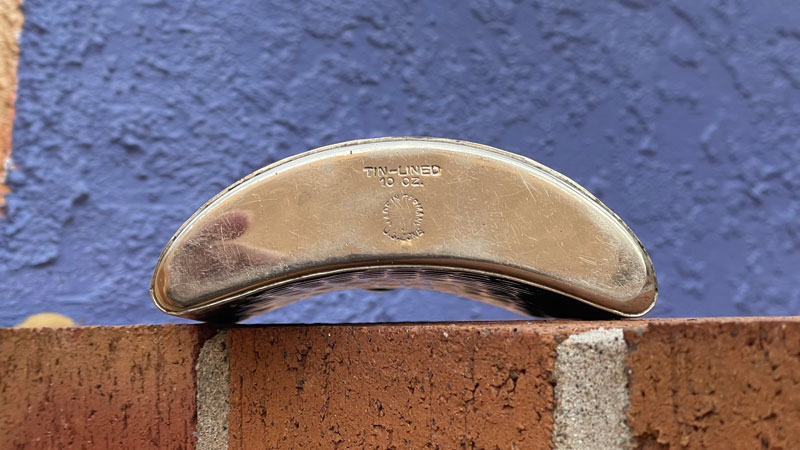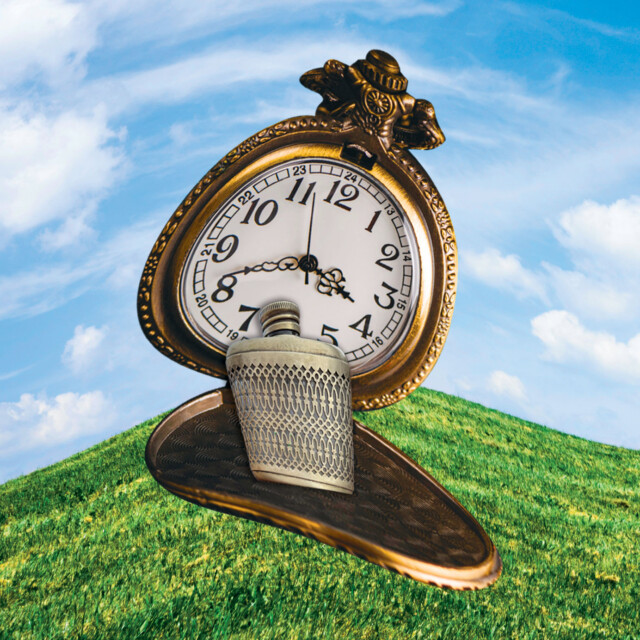This article is a part of our Matters of Taste series, essays from our favorite writers on the artifacts and abstractions they hold most dear in their drinking lives.
“Made in Germany: U.S. Zone” reads the bottom of my late grandfather’s flask.
Every object has a place of origin but so few have the precise time of their creation inscribed into their being. This one is stamped with specific geopolitics, the four year span of a postwar placeholder. It is an artifact rich in history both familial and international.
Thanks to the flask’s 10-ounce volume, and the half-ounce shot glass lid, “Grandfather Flaskerton” became a vessel for blurred understandings, for walking the line between a shot of liquid courage and a daily life of functional alcoholism, shared generationally.
My grandfather’s memory looms large over my life, though I never knew him as an adult. The flask, the inherited vice within, became my touchstone as a young man toward understanding the young adulthood my grandfather must have had. Its origin, stamped on the bottom, gave me an anchor point for discovering what alcohol must have meant to him.
Foreign Bottle Service
The flask was produced at some point between the summer of 1945 and the formation of West Germany in spring 1949. Confoundingly, my grandfather, Alfred Leroy “Roy” Atherton Jr, can be placed in Germany at both the start and end of the German U.S. Zone. In tracking this down, I’m aided by another artifact, an oral history produced by the Association for Diplomatic Studies and Training. Thanks to Roy’s long career in the foreign service, there exists a public and conversational record of his professional life. The document doesn’t mention the flask, but I can at least narrow down when he might have acquired it.
Roy, like much of his generation, ended up fighting in World War II. His artillery unit ended the European war occupying Germany, but in the British zone. The unit was partially demobilized, with some soldiers sent home and others headed to fight in the Pacific. For three months that summer, Roy worked for a government group in the town of Nidda, outside Frankfurt, in the U.S. Zone. This is the first likely candidate for how the flask ended up in his possession.
The flask came to me for my 21st birthday, in a care package from home. I was attending Tulane University in New Orleans, and had already gone through one cycle of discovery, excess, abstinence, and return to moderation with alcohol. Along with the flask came a small photo album, pictures from Roy’s integrated Harvard dorm in the 1940s. Young men, happy and sloshed and slouched. One wore a lampshade.

There is, in drink, a kind of timeless community. Roy passed when I was 13, so I never really got to know him as an adult, but I had a clear sense that he was a drinker. Four or so years before that, I’d spent a week visiting my sheep-raising uncle, intending to learn the chores of the farm. My grandparents joined, which meant that the days were bifurcated: farm labor from 8 a.m. to 3 p.m., then a rush back so Uncle Mike could be the dutiful son and prepare cocktail hour for his visiting parents. That was a kind of drinking, one alien to me at the time.
With the photographs, and the flask, more of the picture slid into place. I knew Roy had loved jazz clubs, and had almost lost his place at Harvard for spending too much time out partying. I had never heard of these friends, these delightful drinking buddies, but I could see in their expressions, in their collapsed-together joyous proximity, an experience very similar to my own as a young man navigating adulthood on a river of abundant alcohol.
The flask became a constant companion. It was always full. I thought of filling it with schnapps, after the drink served by Francois Ehl, the Alsatian Roy’s unit bivouacked with for the winter of 1944. “I can remember Francois Ehl broke out for the occasion one of the best of all his bottles of schnapps, and we all got slightly plastered on schnapps on Christmas Day, 1944,” Roy told the oral historian. I gave up on finding an agreeable schnapps after I think one try, and instead reverted to whiskey, especially bourbon.
When I was feeling flush, I filled Flaskerton with Buffalo Trace or Maker’s Mark. When I was feeling pinched, it was a vessel for Old Crow. I’d share with guests who came over, and some days I’d slip the flask into my messenger bag, riding to campus ready to sip in a buddy’s dorm the moment I no longer had to pretend at a workday.
There’s reason to think the flask might not have come from those few months in Nidda in 1945. Part of it is the absolute state of the country. With German surrender only weeks in the past, the foremost concern was survival. Allied bombs dropped during the war persist in Germany to this day, and the capacity for production, even of items directly for sale to occupying soldiers, was greatly diminished.
Roy returned to Germany in September or October 1947. This time, Roy was an officer in the Foreign Service, and he went to Germany with my grandmother Betty, whom he had married in 1946; her daughter, whose father had died early in the war; and with a two-month old son, my Uncle Michael, who had been born just before. The whole family went to Stuttgart, where they’d spend the next three years, which covered the end of “Germany: U.S. Zone” and the creation of “West Germany.”
In Betty’s oral history, also compiled by the Association for Diplomatic Studies and Training, she said: “In post-war Germany, 1948, there was still nothing to buy. The women exchanged handmade presents and prepared all the food — fairly heavy and starchy, but very good.”
The flask is monogrammed, an ornate “ALA” stamped into the deliberately smooth patch on its dimple-patterned surface. It has the presentation of a gift, perhaps one between a young couple struggling to adjust to the mandated high-society life of Roy’s new profession.
Let the Good Times Pour
In the spring of my senior year, the flask stopped becoming a party novelty and instead became a perpetual companion. I don’t recall drinking it between classes. What I remember clearly is that I would fish it out of my bag after the worst volunteer position I ever had.
With Tulane publicly stating a commitment to rebuild post-Katrina New Orleans, every undergraduate had to take two service-learning courses, one each in the first two and last two years of their studies. For mine, the service was detached from the slot-filling philosophy class, and it saw me biking down twice a week to convince middle schoolers that, if they filled out scantrons for the math worksheets in front of them, they could be rewarded by newer, harder math worksheets until the bell rang. I’d save my drinking for after I left campus, but by the time I made it home my lips were rich with Old Overholt.
My flask — my grandfather’s flask — was at once a comfort and an invitation to disaster. The shot glass made it easy to share, and as a party trick the flask was a delight. The 10 fluid ounces contained inside amounts to, roughly, six and a half standard drinks. Undergrad was a hard-drinking time, and New Orleans is certainly a city with a permissive attitude toward alcohol outdoors. The flask felt like a personal affectation of the overall drinking culture, a way to distinguish my habit from the shithoused escapades of fraternities or the wobbly indulgences of Bourbon Street boomers.
Both Roy’s and my career lead us to Washington, D.C. Foreign service officers are regularly reassigned, and Roy (together with Betty, daughter Lynne, and sons Michael and Reed) would see five postings abroad, as well as one in Berkeley, Calif., between 1950 and 1965. This work often routed through Washington, but it was an unusually long stint at the Near East Affairs desk from 1965 through 1979 that would turn D.C. into my grandparents’ home and my father’s hometown.
I moved to D.C. after graduation to fill an empty room in the apartment of some friends from high school, and to try and stumble into a career at least vaguely related to foreign policy. What I found, for the first year, was a temp job in asbestos litigation data entry. To match my ambition, or at least to justify living in D.C., I threw myself into happy hours. These gatherings, coordinated online in the then-exciting world of “NatSec Twitter,” offered an aspirational community for the war-and-diplomacy adjacent.
Soon enough, I found myself bringing the flask to work to bring to bars. It was a tangible artifact of my grandfather, the date and the monogram serving as an intro before I’d pull up the Wikipedia page or mention that, “Oh yeah, he negotiated Camp David.” But I also never brought it empty. At least once, and maybe more times, I’d sneak a sip in the establishments, stretching my temp wages a little bit more while maintaining the kind of buzz that comes naturally with regular heavy drinking.

Here I finally understood the cocktail hour at the farm, the life of adult conversations over adult drinks that seemed so out of place in rural Oregon. In New Orleans, a night out could last hours, and far from campus people paced themselves. In D.C., happy hours came with tight deadlines, and everyone who commuted in wanted to catch a train home before the lines slowed down. The evenings were condensed. Conversations started on Twitter were hashed out over Aviations, blogs planned over regional beers. D.C., as I understood it, was the animate spirit of this drinking mass, Sazeracs as sacrament.
My Slow Ascent From Alcoholism
The last big outing of the flask that I can remember… well, I can’t. I know I started with friends at one party on New Year’s Eve, 2012. I left and walked, for some time and at some distance, to a bar downtown, near Gallery Place. I know I had the flask out in the bar, and I recall a friend somehow convincing the poor overworked staff to not throw me out for drinking from it at their table.
The next morning, I woke up on a friend’s couch with the worst hangover of my life, took a month off drinking, and wondered how much longer I could keep living in D.C. Not just like this, but at all. The temp gig had ended months ago, I hadn’t gotten another long-term gig yet, and whatever I’d saved was down to rent and groceries, which I was rapidly drinking away. I’d created an imagined version of my grandfather’s D.C. life, but without the insular support of a staff position that sees networking over drinks as an essential job function.
A couple months later, I landed a job in journalism through those same Twitter party connections. The flask, while still a feature of my life, reverted to being a tool of special occasions. My relationship with drinking would have a few more ebbs and flows before arriving at a sensible place, but never again did I feel the need to become spectacle drunk in order to have a career.
I keep Grandfather Flaskerton (empty, these days) in a makeshift bar cabinet, next to the also-empty flask from my maternal great-grandfather. My time in D.C. is now limited to trips back for friends or, rarely, work. My great-grandfather’s flask is heavier. It’s triple plate on glass, leaving a smaller interior, holding only 4.5 ounces, or just three standard drinks. I have, at least once, filled it as a way to deliver a cordial to a party, but it never became the central object of my social existence.
I know nothing of my great-grandfather’s drinking habits. His son, I know, was a drinker for decades, and then gave it up entirely when I was born. The flask came into my possession when he and my grandmother downsized to assisted living. The flask came with his desk, the desk on which I wrote this. It is easy to imagine the flask emerging from a drawer, full and then less so, on long nights in the office.
Without an oral history or youthful photos, I can only conjecture at my great-grandfather’s relation to drink. The flask is well used, but shows no sign of damage. I like to imagine it as a campfire companion, or holding a holiday tipple. Perhaps it was a sleep aid, for whatever called him away from home, in the years before ubiquitous long-distance calls.
Roy’s career, and indeed field, was at least for his stretch of the Cold War, kept afloat on a river of drink. There’s merit to unguarded moments, even if there’s a cynicism to the creation of those moments as a tool of diplomacy. Whatever else I know of the flask, it was a companion through the hard work of peace. Maybe, filled with schnapps, it helped the unresolved questions drift into irrelevance. A problem for another day, another generation.
